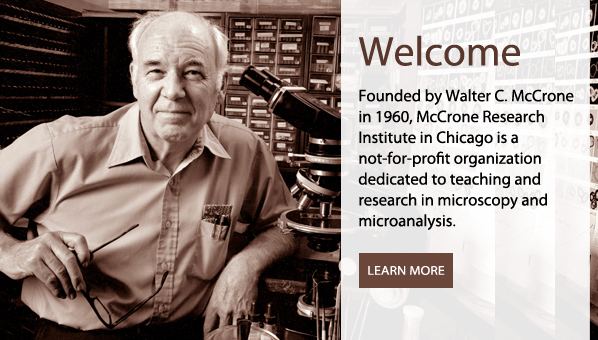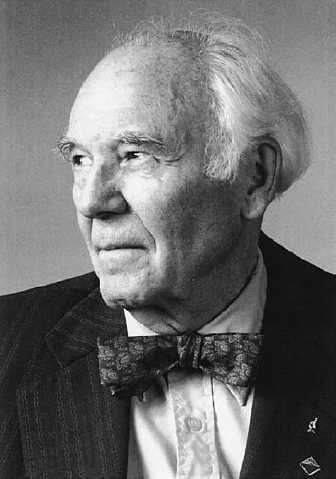Nationality American Name Walter McCrone | ||
 | ||
Born June 9, 1916Wilmington, Delaware, United States ( 1916-06-09 ) Notable awards American National Society National Award Books particle atlas, Judgment Day for the Shroud of Turin Known for Shroud of Turin, Vinland map | ||
Residence United States of America | ||
Walter mccrone
Walter Cox McCrone (1916-2002) was an American chemist who was considered a leading expert in microscopy. To the general public, however, he was best known for his work on the Shroud of Turin, the Vinland map, and Forensic science.
Contents

Biography

McCrone was born in Wilmington, Delaware. At Cornell University he received a bachelor's degree in chemistry (1938) and a Ph.D. in organic chemistry (1942), after which he completed two years of post-doctoral work there. From 1944 to 1956 he was a microscopist and materials scientist at what is now the Illinois Institute of Technology.

Becoming an independent consultant in 1956, he founded McCrone Associates, an analytical consulting firm now located in Westmont, Illinois. In 1960, he founded the McCrone Research Institute, a nonprofit organization for teaching and research in microscopy and crystallography.

For more than thirty years he edited and published The Microscope, an international quarterly journal of microscopy. He also wrote more than 600 technical articles along with sixteen books or chapters. He is credited with expanding the usefulness of the microscope to chemists, who had previously considered it to be primarily a tool for the biologist. In 2000, the American Chemical Society presented him with its National Award in Analytical Chemistry.

McCrone served on the board of directors and as president of the Ada S. McKinley Community Services, Inc., a nonprofit social services agency in Chicago.
McCrone died of congestive heart failure at his home in Chicago.
Shroud of Turin
McCrone's most famous analytical work began with his participation in the Shroud of Turin Research Project (STURP). The Shroud of Turin is a length of linen cloth, claimed by some to be the burial shroud of Jesus and dismissed by others as a medieval fake. Its advocates include the Holy Shroud Guild, established by the Roman Catholic Church in the United States in 1951.
In 1977, a team of scientists selected by the Holy Shroud Guild developed a program of tests that they proposed to conduct on the Shroud. The Archbishop of Turin granted permission. The STURP scientists conducted their testing over five days in 1978. McCrone, upon analyzing the samples he had, concluded that the red stains that had been pointed to as blood were actually pigment—specifically, red ochre and vermilion tempera paint.
Two later additions to the STURP team, John Heller and Alan Adler, published their own peer-reviewed analysis concluding that the stains were blood. (Heller, J.H. and A.D. Adler, "Blood on the Shroud of Turin", Applied Optics, 19:2742-4, 1980; Heller, J.H. and A.D. Adler, "A Chemical Investigation on the Shroud of Turin", Canadian Society of Forensic Sciences Journal 81-103, 1981) According to Shroud skeptic Joe Nickell, neither Heller nor Adler was a forensic serologist or a pigment expert. Nickell adds that, "at the 1983 conference of the International Association for Identification, forensic analyst John E Fischer explained how results similar to theirs could be obtained from tempera paint." McCrone adhered to the fact that comparison of microscopic images showed that the stain on the Shroud was not blood. After all he presented images of the "blood" itself under a microscope which was identical to tempera particles in commercial tempera pigments.
STURP members also disputed McCrone's similar conclusion that the Shroud image was painted. They contended (also in peer-reviewed papers) that physical analyses excluded the presence of pigments in sufficient quantities to be accountable for the image. (For a summary of STURP studies see L.A. Schwalbe, R.N. Rogers, Analytica Chimica Acta 135, 3-49, 1982.)
McCrone resigned from the STURP team in June 1980. In McCrone's words, he was "drummed out" of STURP. Heller, however, stated that McCrone resigned after being "insulted" by the STURP's reviewers' conclusion that the papers McCrone submitted to be vetted for publication contained data that were "misrepresented", observations that were "highly questionable", and conclusions that were "pontifications" rather than "scientific logic" (Heller, Report on the Shroud of Turin, p. 184). Such claims from STURP are hypocritical given the pontifications they have put forward which are demonstrably false, like the claims of blood typing and the claim that the Shroud is a photographic negative. Such claims have been refuted.
Until McCrone's death in 2002, he continued to comment on and explain the analysis he had performed, and he became a prominent figure in the ongoing Shroud of Turin controversy. His book on the subject, Judgment Day for the Shroud of Turin (ISBN 1-57392-679-5), was published in 1999.
Other investigations
McCrone was also involved in other notable historical inquiries. His microanalysis produced evidence that the ink of the Vinland map contained a substance (synthetic anatase) not incorporated in ink until the 1920s, from which he concluded that the map was a forgery. As was the case with the Shroud of Turin, other scientists were involved in studying this object, and some of them reached conclusions that differed from McCrone's. But only McCrone worked microscopically with the tiny physical particles that had been removed from the Shroud with tape in his new laboratory.
On occasion, McCrone was given hair samples of famous people to analyze. Based on such analysis, he rejected the hypothesis that Napoleon had been poisoned with arsenic, but he concluded that Beethoven had suffered from lead poisoning.
McCrone microscopically examined the physical forensic evidence: hairs, fibers, blood, etc. that led to the conviction of Wayne Bertram Williams as the Atlanta child killer.
Pantheon of skeptics
At a meeting of the executive council of the Committee for Skeptical Inquiry (CSI) in Denver, Colorado in April 2011, McCrone was selected for inclusion in CSI's Pantheon of Skeptics. The Pantheon of Skeptics was created by CSI to remember the legacy of deceased fellows of CSI and their contributions to the cause of scientific skepticism.
